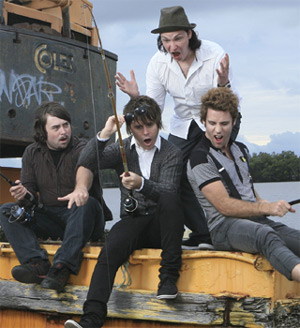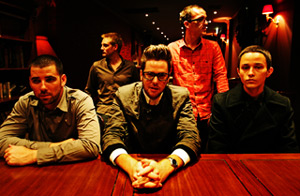The Music Network story: ‘For The Record: An Album Retrospective Part 5’, August 2009
In the final piece of a five-part puzzle, Andrew McMillen examines the digitally-inspired shift in consumer habits away from the long-established album format. After speaking to passionate Australian artists like Hungry Kids Of Hungary, Urthboy and Eleventh He Reaches London last week, Andrew verbally prods two innovative Brisbane-based acts who have turned the album-release expectation on its head.
Were this album-centric article series an actual album, we’d have since bypassed the hit singles, the forgettable middle filler, and the surprising experimental freak-outs. This’d be track twelve; the last gasp that’s strategically-placed to reward the attentive hard-core of fans. Luckily, reader, track twelve is this metaphorical album’s hidden gem: it describes two Queensland acts who’re subverting the traditional cycle in favour of a flexibility that benefits both artist and fan. Press play and get comfortable, won’t you?
 Brisbane natives Drawn From Bees [pictured right] are riding a healthy buzz following their recent national tour and more than a few nods of approval from Triple J. The art-rock four-piece have self-imposed an interesting alternative release strategy: a new record every six months. Explains bassist Stew Riddle: “Over a few drinks after our first rehearsal last year, we decided to use the fact that we’re a band of four songwriters to our advantage, and aim for a prolific introduction to the band. We felt that it would be interesting to break from the new-band cycle of ‘release an EP, tour for 6-12 months, release another EP’, and instead try to put something out every six months.” But the Bees are in a unique situation that encourages frequent releases; Riddle admits: “Dan, our singer, is also a producer, so we can afford to record very cheaply. If we had to hire studio and producer time, it might be a very different story.”
Brisbane natives Drawn From Bees [pictured right] are riding a healthy buzz following their recent national tour and more than a few nods of approval from Triple J. The art-rock four-piece have self-imposed an interesting alternative release strategy: a new record every six months. Explains bassist Stew Riddle: “Over a few drinks after our first rehearsal last year, we decided to use the fact that we’re a band of four songwriters to our advantage, and aim for a prolific introduction to the band. We felt that it would be interesting to break from the new-band cycle of ‘release an EP, tour for 6-12 months, release another EP’, and instead try to put something out every six months.” But the Bees are in a unique situation that encourages frequent releases; Riddle admits: “Dan, our singer, is also a producer, so we can afford to record very cheaply. If we had to hire studio and producer time, it might be a very different story.”
Two EPs into their two-year experiment, Riddle contemplates the band’s feeling toward the album format: “I tend not to think about what we’re doing in terms of working towards an album, as to me, the length is largely irrelevant. I feel that each record needs to make a statement, and to be a snapshot of where the band is at that particular time. Our third release is looking to be an 8 or 9 track record that has a more melancholy flavour. Is it an album or an EP? We don’t know, so we’ll just call it a record and let other people decide!”
When asked where he thinks the album format belongs in the future of music, Riddle is sceptical. “It’s a hard one to judge. It seems that while the physical single is dead, the digital single is now king. No one buys albums anymore, but if you look on my friends’ mp3 player, they tend to collect not just full records, but full catalogues of acts that they love. I think that the album will live on. Certainly, at least in the sense of releasing bodies of music that make various statements at different points in an act’s career. Does it mean that the length of an album will remain between 30 and 70 minutes? Maybe not. Musicians aren’t constrained by the format anymore; vinyl and plastic don’t dictate the length.” With a fourth release due around Christmas to bring the four-EP commitment to a close, what’s next for Drawn From Bees? “We’ll probably do an album. Or a greatest hits box collection, who knows?” laughs Riddle.
From a regular-release ideal to a staggered album: meet Brisbane indie rock band 26 [pictured below left], who’re midway through an ambitious project to release a twelve-track album in three-song installments every three months. After releasing two albums in the standard manner since their 2005 debut The King Must Die, singer/guitarist Nick O’Donnell explains the genesis of the concept dubbed 26×365: “We don’t sell all that many hard copies anymore, so we decided to release the next album in small portions. We were finding that people were buying singular songs rather than the whole albums off of iTunes.”
Each of the four parts to 26×365 is priced at $3.39. O’Donnell continues: “We thought maybe we could package a couple of songs together at a lower price point and you could get people buying them because they think they’re getting a bargain, as they’re getting three songs for the price of two. By April next year we’ll have the twelve songs that you can buy as a whole product, but our true fans can get the songs every three months. This allows us to introduce the songs gradually into our live set; in terms of the record, it’s like our fans are coming along for the ride.”

With the new release, the band are aiming to reduce the comparative tedium that they’ve experienced with past releases. “It’s not like the situation where the band records the whole album and they’re already already kind of over the songs; you know, you’ve already been playing the songs for a year or so. As an artist, you get to the end of the album process and the songs aren’t fresh for you, but they are for the public. So you’re pretending that they’re new to you, but they’re not.”
The band’s website further addresses the reasoning behind the project. Perhaps unwittingly, 26 have put their heads together and specified a bold manifesto for independent artists the world over. 26 state:
Unless you’re Coldplay, Metallica or Andre Rieu, the one thing a band must do is maintain momentum. Peoples’ attention span is becoming shorter and shorter, so we want to be attracting CONSISTENT attention.
The 26×365 release process will allow:
- New material to the audience, but not so quickly that it will lose its impact.
- Offer a time-based point of interest for the band
- Allow the audience to see how we are progressing as a band
- New content for an entire year, including pictures, videos, blogs, and give aways
- New gig material for an entire year and having it ready for consumption on iTunes. No waiting for the whole album to be released.
The purpose of this article series is not to eulogise the demise of the album, or to bemoan the recording industry’s omissions. Instead, it’s to highlight that right now is a better time than ever to consider the ideal manner in which to distribute music to an artist’s fanbase. For independent artists, a direct artist-fan (one-to-one) connection may be the most appropriate business avenue. For bigger artists – the aforementioned Coldplays and Andre Rieus – a one-to-many, traditional distribution method may still be the ideal outcome. The keyword in this discussion is choice. Not only do customers now have the ability to choose how they consume music with more freedom than ever before; now, artists are privy to a wealth of release strategies, business models, digital distributors, while still retaining the option to engage in traditional physical product manufacturing and distribution.
“A lot of purists tend to complain now that an album’s artwork is gone. I think it’s really great, because what has gone is all the shit surrounding the music. You can still get the music itself, so you’re getting the purest version of the art, because it’s just the music. It’s nothing else.” – Nick O’Donnell, 26.
Brisbane-based Andrew McMillen writes for several Australian music publications. He can be found on Twitter (@NiteShok) and online at http://andrewmcmillen.com/
(Note: This is part five of an article series that first appeared in weekly Australian music industry magazine The Music Network issue #748, July 27th 2009. Read the rest of the series: part one, part two, part three, and part four)
 Brisbane’s
Brisbane’s  “I’m still a huge fan of putting on an album and listening to it all the way through. It’s very rare to experience an album that you can listen to from start to finish, and not get bored. It’s very rare to experience that, and it’s one of the things you look forward to in life, as a music fan – that next band that you’ll become completely obsessed with.” When questioned about the free MP3 downloads offered on the band’s Last.FM profile, Donaldson continues: “It’s still good for people to be able to download a song in reasonable quality, just in case they are thinking about downloading the full album. Because we’ve basically arrived at the situation where you can download a song for free, get a feel for the quality of it, and then decide whether you want to waste your bandwidth on it!”
“I’m still a huge fan of putting on an album and listening to it all the way through. It’s very rare to experience an album that you can listen to from start to finish, and not get bored. It’s very rare to experience that, and it’s one of the things you look forward to in life, as a music fan – that next band that you’ll become completely obsessed with.” When questioned about the free MP3 downloads offered on the band’s Last.FM profile, Donaldson continues: “It’s still good for people to be able to download a song in reasonable quality, just in case they are thinking about downloading the full album. Because we’ve basically arrived at the situation where you can download a song for free, get a feel for the quality of it, and then decide whether you want to waste your bandwidth on it!” It’s a valid comment, given that hip-hop song structures are perhaps more reliant on narrative than their rock counterparts. When asked about digital distribution’s effect on the album format, Levinson concedes: “It’s slowly changing people’s attitudes and expectations toward consumption of music. We’re in a transition period where albums retain a huge significance – but some signs suggest it’s disappearing. Stranger things have happened and trends don’t always result in their predicted outcome, though.”
It’s a valid comment, given that hip-hop song structures are perhaps more reliant on narrative than their rock counterparts. When asked about digital distribution’s effect on the album format, Levinson concedes: “It’s slowly changing people’s attitudes and expectations toward consumption of music. We’re in a transition period where albums retain a huge significance – but some signs suggest it’s disappearing. Stranger things have happened and trends don’t always result in their predicted outcome, though.” To elaborate on the latter example: picture the average album you’d buy from a store – perhaps not in this era, since both CD shelf space and CD merchants continue to dwindle – but ten years ago. Hypothetically, the disc is likely to be front-loaded with some great songs. They’re the ones that you’re likely to have heard before you bought the album. These strategically-placed songs are the ones that either – or both – the band and record label wanted you to hear first and enjoy first.
To elaborate on the latter example: picture the average album you’d buy from a store – perhaps not in this era, since both CD shelf space and CD merchants continue to dwindle – but ten years ago. Hypothetically, the disc is likely to be front-loaded with some great songs. They’re the ones that you’re likely to have heard before you bought the album. These strategically-placed songs are the ones that either – or both – the band and record label wanted you to hear first and enjoy first. That listening habit was exploded when CD burning technology allowed listeners to compile the circular equivalent of mixtapes, without the cassette-associated fuss. As the audio filetype known as MP3 became easier for the masses to acquire online, consumer attitudes to music further deviated from the past when the first digital audio players became available in the late 1990s.
That listening habit was exploded when CD burning technology allowed listeners to compile the circular equivalent of mixtapes, without the cassette-associated fuss. As the audio filetype known as MP3 became easier for the masses to acquire online, consumer attitudes to music further deviated from the past when the first digital audio players became available in the late 1990s. In 2009, artists shouldn’t automatically sprint toward the album endpoint as a result of historical programming. Their creative output shouldn’t be stretched to meet the 45 minute/12 track (whichever comes first) expectation, just so that the parties involved can proudly call it an album. In an era where more music is being written, recorded and performed each day than at any other point in history, an artist shouldn’t throw together words, chords and beats just to meet an expectation built upon a decades-old concept.
In 2009, artists shouldn’t automatically sprint toward the album endpoint as a result of historical programming. Their creative output shouldn’t be stretched to meet the 45 minute/12 track (whichever comes first) expectation, just so that the parties involved can proudly call it an album. In an era where more music is being written, recorded and performed each day than at any other point in history, an artist shouldn’t throw together words, chords and beats just to meet an expectation built upon a decades-old concept.